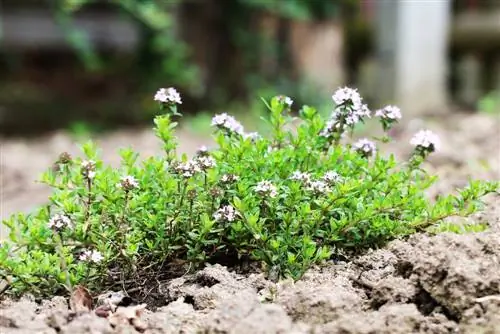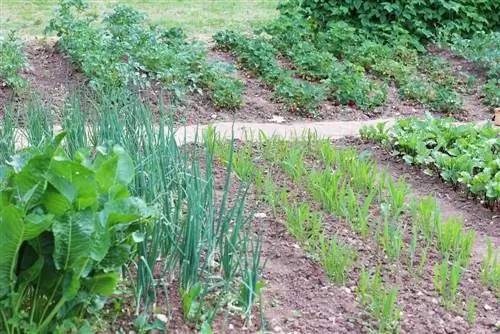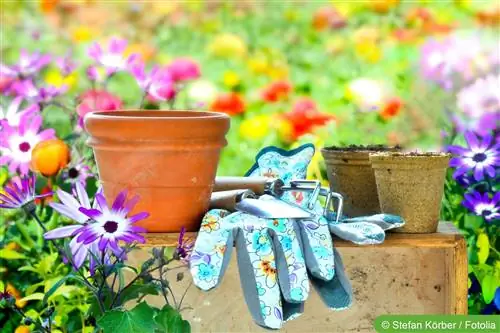- Author admin [email protected].
- Public 2023-12-17 03:39.
- Last modified 2025-01-24 12:45.
Both horn shavings and horn meal are made from the horns and hooves of cattle. They only differ in the fineness of their grain. They are organic fertilizers. Their effect only occurs gradually, depending on the degree of grain size and soil composition. Nitrogen is only released slowly as the material in the soil decomposes. Negative effects such as those with concentrated chemical fertilizers are therefore not to be feared.
Composition
The cattle horns and claws are ground up to make horn fertilizer. They are available in specialist retailers in different fineness levels, such as: horn shavings, horn meal, horn semolina and horn meal. Horn meal works fastest with a grain size of less than 1 millimeter. The period in which the horn fertilizer decomposes in the soil ranges from a few days (for horn meal) to a few months (horn shavings). Horn fertilizer mainly supplies nitrogen, the average content is 14%. The pH value is neutral.
Effect
Horn fertilizer enriches the soil with nitrogen. However, bacteria and other microorganisms in the soil must first break down the horny material. This happens slowly and in small portions. Nitrogen is a chemical element (N) and a component of proteins. It is an important building material for the genetic makeup and chlorophyll of plants. Too little nitrogen means the plant grows poorly, develops pale green leaves or turns yellow. A nitrogen deficiency can also lead to early flowering, a so-called emergency flowering. The desired effect does not only depend on the fineness of the horn fertilizer. The soil conditions and the weather also play a crucial role. A he althy soil, with many microorganisms, loose and with good drainage, can process the fertilizer optimally.
Application
Time
When is the right time for horn fertilization? This depends on the fineness of the fertilizer. Horn shavings can be brought to the countryside at the beginning of the season. This gives the plants a gentle start. They are looked after for up to three months, then they can be fertilized again. The main times for fertilization are spring and summer. With horn meal you can provide the plants with additional, quickly available nitrogen if necessary. Fertilizing with horn shavings or meal makes no sense in autumn and winter. The microorganisms in the soil are then no longer as active, and most plants only need a few nutrients during their rest period. Depending on the degree of grain size, the nitrogen is available to the plants one week after fertilization (horn meal). For horn shavings it takes up to 4 weeks.
Tip:
For the sake of their he alth, vegetables should no longer be fertilized with nitrogen 3-4 weeks before harvest. Because the nitrogen is stored in the foliage.
Applying
The horn shavings and horn meal are distributed evenly, preferably in a wide spread on moist soil. Then work the substrate lightly into the ground with a rake. If new plants are planted, you can also add the fertilizer directly into the planting hole. The dosage of horn shavings does not have to be adhered to exactly, you calculate for one square meter:
- for weak eaters: 30 g
- for heavy eaters: 70 g
- for lawn: 30 g
Horn shavings are particularly suitable as an organic fertilizer for vegetables and green plants. With the grain size, heavy and weak feeders in the bed can be individually supplied. While the weak feeders are usually already served with horn shavings fertilization in the spring, heavy feeders can be further supplied with horn meal as needed. A weak lawn quickly gets a new boost with horn meal. Horn shavings applied to the lawn at the beginning of the growing season provide it with nutrients for an entire season.
Tip:
Incorporating horn shavings into the compost promotes rotting and increases the quality of the compost.
Notes
Weeds should be removed before fertilizing. Horn shavings nourish all plants equally. As already mentioned, the horn shavings are spread widely onto the bed or lawn as a long-term fertilizer. Moist soil is an advantage. It can then be easily incorporated. If nutrient in the form of nitrogen is needed immediately, horn meal can be spread around the relevant plant. There is no need to be afraid of over-fertilization. Nitrogen can escape through the air, so it is always better to work the fertilizer applied superficially into the soil. If you sprinkle horn meal on the lawn, incorporation is not necessary. If possible, horn fertilizer should not be used in combination with other biological nitrogen fertilizers.
If you want to mulch your beds, it's a good idea to spread horn shavings first and then the mulch first. Mulch requires a lot of nitrogen to decompose, which would otherwise be removed from the soil. Horn shavings can also be processed into liquid fertilizer. This means that plants in pots and boxes can also be supplied with nitrogen if necessary. To do this, pour the horn shavings with water. This brew can be left to steep for up to 4 days. Just a small glass of schnapps added to the irrigation water is enough to compensate for a lack of nitrogen. Horn fertilization is not suitable for hydroponics. When building a raised bed, you can mix horn shavings into the compost layers.
Due to the special smell that comes from the natural materials, some dogs react to them more or less strongly. So some start digging in these places or try to eat the horn shavings. This is not dangerous for the dog as long as it is pure horn shavings without any additives. Be sure to read the instructions on the packaging. Occasionally there are also additions of castor bean meal. This can cause vomiting and bloody diarrhea in dogs.
If you are still hesitant to fertilize with this organic fertilizer because of BSE (colloquially known as mad cow disease): Fertilizer based on the horns and claws of cattle has been tested as harmless. Especially since these products are only obtained from slaughtered cattle and do not come from slaughterhouses.
All types of horn fertilizer are available from specialist retailers. 10 kg costs around 20 euros and is enough for 50 to 100 square meters of land.
Tip:
A pleasant side effect of fertilizing with horn shavings: Snails don't like contact with horn shavings. They even avoid plants that have been supplied with horn fertilizer.
Conclusion of the editors
Fertilization with horn shavings and horn meal is an environmentally friendly alternative to artificial nitrogen fertilizers. They not only ensure he althy growth of plants, but also enhance the soil by nourishing the microorganisms in it.
What you should know about horn shavings in brief
Horn shavings and horn meal offer numerous benefits for vegetable gardeners. They are completely organic, which is why they can also be used by organic farmers or hobby gardeners who attach great importance to organically flawless vegetables. The vegetables that have been treated with the natural fertilizer also become particularly tasty because horn shavings contain high-quality nutrients and trace elements that are supplied to the vegetables. It's easy to use:
- You just need to throw out the non-toxic fertilizer and lightly add it to the soil,
- then water every now and then and the vegetables will grow better and faster.
Especially those who have small children or pets can breathe a sigh of relief. They no longer need special supervision, but can once again run around in the garden without any problems or worries. If you think there has to be a catch, you're wrong:
- Even the price of horn shavings and horn meal is not particularly high. A 5 kg bag costs just under 10 euros.
- The product is available either in garden or hardware stores or in the internet shop.
- The application is described again on the package insert, but it works very easily and without any problems.
By the way: it's not just the vegetable garden that can be treated with it. So that you don't need several different types of fertilizer and the garage doesn't gradually become too cramped due to the many fertilizers, horn shavings and horn meal have another advantage: they can be used for all areas of the garden. In addition to vegetables and the lawn, even bushes and flowers can be fertilized, making additional fertilizer unnecessary.






